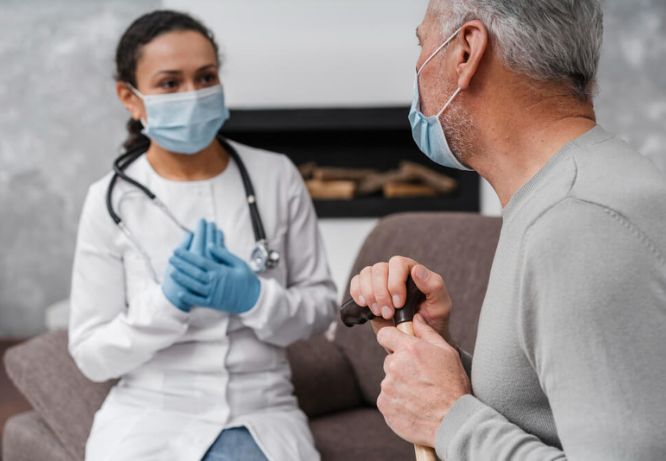Cancer is a global health problem with new cases numbering in the millions yearly. Even in India, where the cancer load is rising, the earliest possible diagnosis and treatment are crucial for enhancing survival and the quality of patient results. Delayed treatment is a cause for concern and increases mortality while diminishing the quality of life. The causes for such delays are multifarious, comprising systemic inefficiencies, cost implications, unawareness, and infrastructural shortcomings. The present article examines the effect of extended waiting times on cancer survival rates in India and underscores the need for early intervention.
The Necessity for Early Cancer Treatment
Early diagnosis and early treatment are imperative in the management of cancer. There has always been evidence that the earlier a patient is treated, the higher the survival rate. Cancer develops in steps, and a delay of a few weeks may give the development of disease enough time to render the available treatments less effective. For example, in aggressive forms of cancer like lung and pancreatic cancer, a delay in treatment can dramatically decrease survival rates. On the other hand, cancers such as colon and breast cancer are easily treatable if detected early and immediately treated.
Cancer treatment waiting times in India, where health services are frequently strained, may range from a few weeks to a few months. This can be potentially lethal to the majority of patients since the cancer will spread, become more difficult to cure, and be more likely to recur even with treatment.
Reasons for Delay in Cancer Treatment
1. Inadequate Healthcare Infrastructure
Poor health infrastructure is one of the main reasons for delays in cancer treatment. There are limited cancer centers of excellence in a highly populated country like India. While advanced oncology units are available in metropolitan cities, rural towns are deprived of fundamental diagnostic and treatment facilities. Thus, patients must go long distances to receive special care, resulting in severe treatment initiation delays.
2. Shortage of Oncologists and Medical Staff
A shortage of professional cancer specialists is one of the key issues. India does not have adequate oncologists, radiologists, and pathologists, and so long waiting lists are experienced for visits to the doctor, investigation tests, and therapy. Even at government hospitals, the ratio of doctors to patients is very low because the majority of patients receive treatment due to the cost factor. It takes weeks for a patient to get an appointment with a cancer doctor in India, a specialist, which causes unnecessary advancement of the disease.
3. Treatment Cost and Financial Constraints
Cancer treatment is costly, and most patients in India cannot afford to pay for treatment on time. Government programs and private insurance programs have enhanced the availability of treatment, but most individuals need to pay for treatment out of pocket. Out-of-pocket payment leads to a delay in treatment until money is raised, and it leads to poor outcomes.
Moreover, investigation methods like biopsies, MRIs, and PET scans are expensive and not always available under routine medical schemes. The poor can most often defer such investigations because of cost, thus causing delayed diagnosis and treatment.
4. Delayed Diagnosis due to Lack of Awareness
A high percentage of cancer patients in India are diagnosed late because of a lack of awareness. Most people are not aware of early symptoms and signs and regard them as trivial illnesses. Additionally, cultural taboos for cancer do not allow people to visit hospitals for treatment because they fear social rejection. By the time the diagnosis is made, cancer would have reached an advanced stage, hence reducing the chances of treatment and survival.
5. Bureaucratic and Administrative Barriers
Despite an early diagnosis of patients, treatment is delayed frequently due to administrative roadblocks. Government hospitals dealing with massive volumes of patients make patients pass through multiple levels of clearance before therapy is initiated. From sending pathology reports to getting slots in surgery, chemotherapy, or radiotherapy, administrative inefficiencies hold back treatment. Even though private hospitals are quicker, they are, in the majority of instances, well beyond the reach of a lot of patients.
Effect of Delay on Survival Rates
Delayed treatment significantly influences the survival rate of cancer patients. Extended waiting times, as research has revealed, reduce survival rates, raise the likelihood of metastasis, and restrict the number of available treatments.
1. Reduced Survival Rates
The rate of survival of cancer patients is severely reduced with the delay in treatment. For instance, a greater than three-month delay from diagnosis to operation in breast cancer decreases survival by 10-20%. In head and neck cancers, also common in India owing to smoking habits, more than 60 days’ treatment delays have been observed to decrease five-year survival by almost 30%.
2. Enhanced Chances of Metastasis
An untreated cancer for a long time will also metastasize to other regions of the body, and hence it becomes harder to treat. For example, patients with prostate cancer who have treatment delays of six months or more are at high risk of acquiring metastatic disease, which results in considerably reduced survival and increased demand for aggressive treatment.
3. Decreased Efficacy of Treatment
Delays in treatment can render some therapies useless. When chemotherapy is required before surgery, any delay will make the cancer drug-resistant. The same goes for radiation therapy, which is most effective when given at the right time; delay, and the tumor advances, making treatment more complicated.
Potential Solutions to Reduce Delays in Cancer Treatment
A multi-pronged strategy will be needed to check delays in cancer treatment in India, including government action, enhanced health policy, and increased public awareness.
1. Enhancing the Health Infrastructure
Increased cancer care centers in rural and semi-urban regions can help decrease waiting time. Regional cancer centers with treatment and diagnostic units can make patients not travel long distances for treatment. The government can also invest in telemedicine services so that patients can receive remote consultations and early screening.
2. Increase the Oncologists
There must be additional oncologists and cancer specialists trained to cater to patient needs. Offering scholarships for pursuing cancer courses for medical students can prompt professionals to adopt the profession. Additional general practitioners can be trained to identify cancer symptoms so that they can refer the patients early and the physician can make a proper diagnosis.
3. Subsidized Treatment and Financial Aid
Providing government-led cancer treatment made affordable and within reach through subsidies, insurance, and schemes by the government can enable treatment without financial anxiety for patients. Scaling up Ayushman Bharat-type programs and integrating them with private providers will make effective cancer treatment more accessible to everybody.
4. Public Awareness and Early Screening Programs
Generating awareness about cancer symptoms and early detection is essential. National screening programs, particularly for cancers with high risk such as cervical, breast, and oral cancer, can detect cases at an early stage. The government and non-government agencies must come together to generate awareness among individuals regarding cancer risks and regular check-ups.
5. Simplification of Administrative Procedures
Minimizing delays due to bureaucracy in government hospitals will enable patients to receive treatment on time. A fast-track system for cancer patients, in which diagnostic tests and approvals are speeded up, can minimize waiting times to a great extent. Computerized patient records and appointment scheduling can also enhance efficiency.
Conclusion
Cancer treatment delay remains a matter of serious concern in India, impacting the survival of the patients and overall patient outcomes. Unnecessary waiting times are initiated by infrastructural shortcomings, financial constraints, shortage of specialists, and bureaucratic inefficiencies. Unless some dramatic change occurs, most cancer patients will remain deprived of appropriate care and diminished survival opportunities.
Dr. Vikesh Shah puts in the limelight the necessity of systemic change in cancer treatment. If you or your loved one requires expert advice on cancer care, contact us today for consultations and advice. Early cancer detection and treatment can be life-saving.

